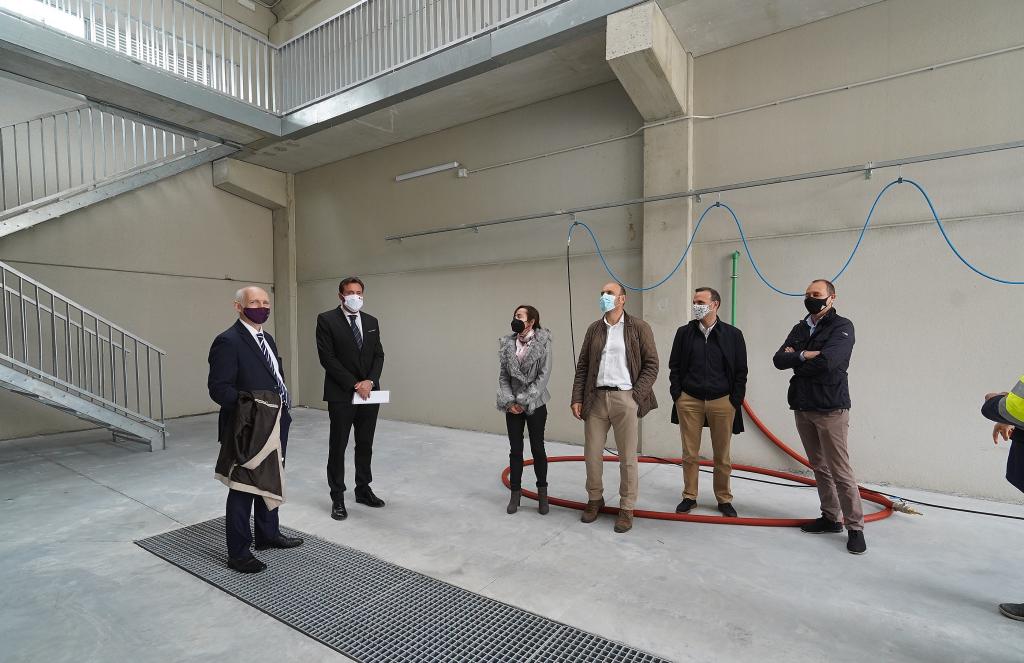Thessaloniki gets ready for its metro launch in November
The underground rapid transit lines have been under construction for almost two decades due to various project delays
 TheMayor.EU logo
TheMayor.EU logo 
Valladolid officials at the presentation of the vehicle washing station, Source: Ayuntamiento de Valladolid
Thanks to the construction of a specialized facility – the first of its kind in Spain
On 27 April, the Valladolid City Council reported that it had invested more than 1.1 million euros for the construction of a specialized facility to service the 130 vehicles used by the municipal cleaning service. What is unusual about this is that it is the first such unit in Spain and its construction was carefully designed to meet the contemporary standards of energy efficiency and sustainability.
Valladolid’s Cleaning Service owns a variety of vehicles that are required these days for the proper maintenance of the urban landscape of any modern city. These include sweepers but also waste collection trucks and other auxiliary vehicles, as the services provided include trash collection and street washing.
Up until now, the washing of the fleet was done in a section of the mechanical workshops, where the maintenance works are done. The problem with that is that it failed to provide a good aesthetic result since the workers did not operate under optimal conditions, not to mention the effect of humidity and odour generated from mixing the two washing and maintenance under one roof.
The building is a compact concrete prism, with a sandwich panel and polycarbonate roof, facing south to optimize the performance of its photovoltaic panels.
It is structured into five independent truck wash modules, two facilities rooms and a toilet. One of the modules is intended for the automatic washing of underbody, the boxes and disinfection. The others are used for manual washing with intakes that allow high-flow and high-pressure washing, optimizing the use of water and detergents. One of them has also been enabled to wash the upper part of the trucks.
One of the integrated systems that feature unique design is the one responsible for conducting and treating the water contaminated by the washing process, which also carries numerous solids. The water collected in the washing box is led through a network of pipes and manholes to the roughing area, which is made up of a grit area, a coarse grating, a sieve and another separator of hydrocarbons and floating material.
The building has a high thermal demand, due to the high consumption of hot water necessary for the cleaning process. So, designers opted for a heat-generating system that reduces the carbon footprint, consisting of a hybrid natural gas/electricity, with a 100-kW condensing boiler and an aerothermal heat pump with high seasonal efficiency, supported by photovoltaic energy.
The control system continuously decides what type of energy to consume, with the idea of promoting energy savings and reducing costs. Furthermore, the surplus photovoltaic energy is used for powering the rest of the installation (things, such as pumps and lighting).

The underground rapid transit lines have been under construction for almost two decades due to various project delays

Now you can get your wine in Talence by paying directly in Bitcoin

That’s because the state has to spend money on updating the railway infrastructure rather than subsidizing the cost of the popular pass

Rethinking renewable energy sources for the urban landscape

The examples, compiled by Beyond Fossil Fuels, can inform and inspire communities and entrepreneurs that still feel trepidation at the prospect of energy transition

Now you can get your wine in Talence by paying directly in Bitcoin

The 10th European Conference on Sustainable Cities and Towns (ESCT) sets the stage for stronger cooperation between the EU, national and local level to fast track Europe's transition to climate neutrality.

At least, that’s the promise made by the mayor of Paris, Anne Hidalgo

The underground rapid transit lines have been under construction for almost two decades due to various project delays

At least, that’s the promise made by the mayor of Paris, Anne Hidalgo

Hostal de Pinós is located in the geographical centre of the autonomous region

Despite its church-y name, the district has long been known as the hangout spot for the artsy crowds

Urban dwellers across the EU are having a say in making their surroundings friendlier to people and the environment.

Forests in the EU can help green the European construction industry and bolster a continent-wide push for architectural improvements.

Apply by 10 November and do your part for the transformation of European public spaces

An interview with the Mayor of a Polish city that seeks to reinvent itself

An interview with the newly elected ICLEI President and Mayor of Malmö

A conversation with the Mayor of Lisbon about the spirit and dimensions of innovation present in the Portuguese capital














